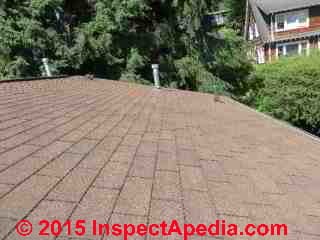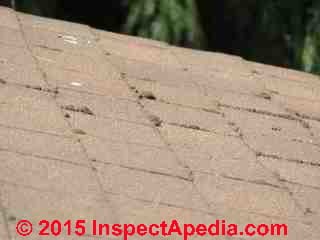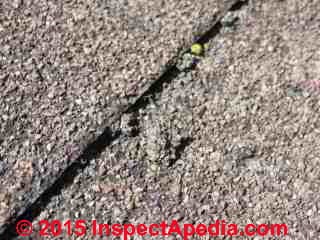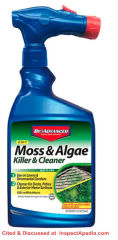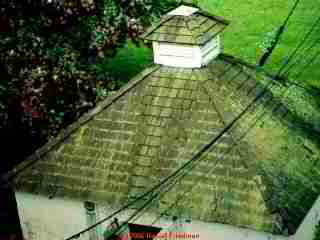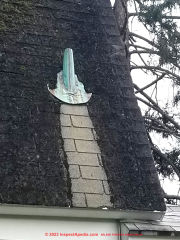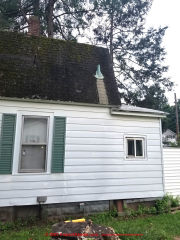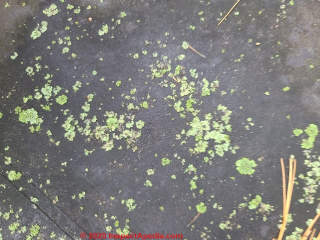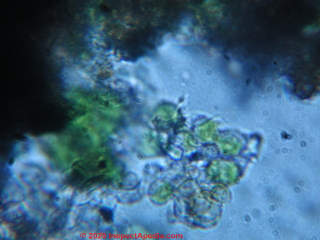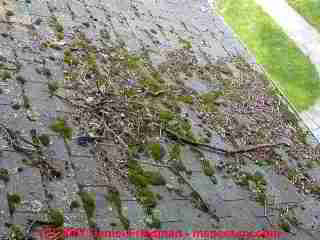 Identify, Remove, Prevent Algae, Fungus, Lichens, Moss on Roofs
Identify, Remove, Prevent Algae, Fungus, Lichens, Moss on Roofs
- POST a QUESTION or COMMENT about cleaning off moss from building roofs
Moss on roofs or roof shingles:
Here we explain the causes of algae, moss, lichens, or fungal growth on roof shingles, the effects of these conditions, and how to cure or prevent them.
Just brushing or raking off moss won't prevent future moss growth, and if roof cleaning is not done with care you risk damaging the shingles and reducing the life of the roof.
Roof treatments to prevent or remove lichens & moss include use of metal flashing strips, algae-resistant shingles, or chemical treatments. Other roof cleaning procedures such as power washing or sweeping are discussed (and are not recommended).
InspectAPedia tolerates no conflicts of interest. We have no relationship with advertisers, products, or services discussed at this website.
- Daniel Friedman, Publisher/Editor/Author - See WHO ARE WE?
Algae, Fungus, Lichens, Moss Effects on Asphalt Shingle Roofs
 Causes of moss or lichens growth on roofs
Causes of moss or lichens growth on roofs
Moss growing on any roof surface will be more severe on roof sections that area shaded and exposed to periodically damp cool weather conditions.
The presence or absence of much sunlight on a roof surface is often a determining factor in the amount of moss or lichens growth (more sun, less moss and lichens. When shade and cool moist conditions combine, moss or lichens growth on a roof surface is more likely. [1]
Moss and lichens are more than a cosmetic issue
on many kinds of roofing materials - asphalt shingles, roll roofing, wood shingle roofs, wood shake roofs.
By holding moisture against the roof surface lichens but more so moss speed the wear of the asphalt shingle surface in freezing climates by increasing frost damage to the mineral granule coating on the shingles.
Sometimes there is so much moss and crud on a roof that we're not sure what roofing material was used.
The photo below is actually of a wood shingle roof, though it may make more sense to call this a moss roof in Rhinebeck, New York.
What are the effects of moss growth on roofs?
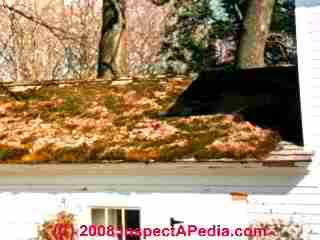 Because moss or lichens growing on a roof surface will hold moisture on the roof longer than other areas, these growths can reduce the
life of the roof covering.
Because moss or lichens growing on a roof surface will hold moisture on the roof longer than other areas, these growths can reduce the
life of the roof covering.
Particularly where the roofing materials are asphalt shingles or wood shingles, holding water on the roof surface by any means (leaves, debris, moss, or lichens) speeds up wear on these shingles. In freezing climates there may be faster frost damage, cracking, and wear of the shingles under the moss or lichens.
Even in non-freezing climates, the roots or growth structures of moss or lichens eventually penetrate and separate the roof shingle materials, speeding their demise.
[Click to enlarge any image]
Is lichens on a roof as much of a problem as moss?
Because lichens growing on a roof surface does not have as much thickness of body as moss, it will hold less water on the roof surface and is less of a wear factor than moss.
Therefore if we have only lichens growing on a roof surface we would be less quick to try to clean it off since lichens not only has a tighter "grip" on the roof surface but the cleaning process for lichens risks doing more harm than good to the roof surface.
At ALGAE, FUNGUS, LICHENS, MOSS COMPARED we show photographs of lichens damage to asphalt shingle roofs.
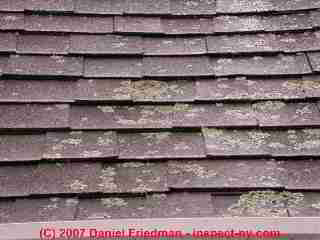 Is green or black algae on roof shingles as much of a problem as moss or lichens?
Is green or black algae on roof shingles as much of a problem as moss or lichens?
Algae on a roof surface appears as a thin green coating which is mostly a cosmetic concern.
The presence of algae on the roof is an indicator that this roof area is in a shaded spot where you may want to be alert for development of moss or other roof problems, but the level of damage from algae is probably low, even less than that caused by lichens.
Avoid any aggressive cleaning methods that might damage the roof surface.
Black algae stains on asphalt singles
Some black stains on asphalt roof shingles are caused by a black algae (sometimes misnamed as a black fungus or even a "mildew") such as that shown in the photograph here.
Black algae stains may be mistaken for but are not "extractive bleeding" - a product cosmetic defect.
When the staining or bleeding appears to run down the roof from individual small points or "spots" we think this is extractive bleeding or "bleed through" on shingles.
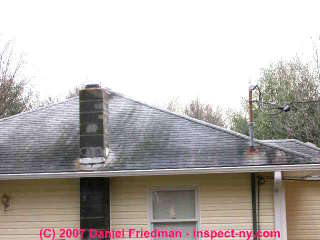 See ALGAE STAINS on ROOFS
See ALGAE STAINS on ROOFS
and
also STAINS on ROOF SHINGLES for a more detailed discussion of bleed through or extractive bleeding as well as black algae stains on roof shingles.
When black stains on the roof surface are more uniform and cover a wide area that does not originate at one or more single pinpoints in the shingles, this may be a black algae growing on the shingle surface.
As we said about green algae on roofs, the presence of these black fungal or algal stains on the roof is an indicator that this roof area is in a shaded spot where you may want to be alert for development of moss or other roof problems,
but the level of damage from the black fungus or algae is probably low, even less than that caused by lichens and certainly less than that caused by moss.
Avoid any aggressive cleaning methods that might damage the roof surface.
How to clean off mossy or lichens-covered roofs
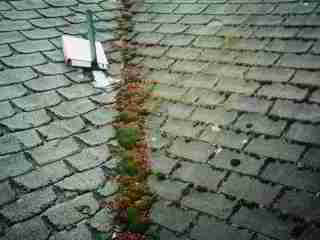
Do not try to clean a roof like the one shown
in this photograph. The shingles are worn out and fragile. It will be impossible
to clean the roof without damaging it. A new roof is needed.
In our opinion, any roof surface brushing or raking should be done with great care to minimize damage to the shingles themselves. If there is any doubt about the condition of the shingles underneath the moss, work gently by hand on a small area first to see the condition of the shingles below.
If the roof shingles are fragile, brittle, cracking, curled, the risk of serious damage to the roof during moss removal is much more likely. The roof may look cleaner, but its remaining life may be reduced by aggressive cleaning.
Power washing or brushing:
it is possible to remove moss from a roof surface by gentle cleaning using a soft brush or a power washer.
Watch out: power washing or even brushing or sweeping an asphalt shingle roof (or a wood shingle roof in old, worn, fragile condition) is itself a process that can damage the roof by breaking shingles or by loosening the protective mineral granules from the shingle surface.
As stated at ASBESTOS ROOFING / SIDING POWER WASHING we do not recommend power-washing asphalt shingles nor asbestos-cement roof shingles nor any other roofing product that can be damaged by high pressure spraying.
Raking off roof moss:
using a flexible leaf rake to remove moss, providing the raking is done gently, may be easier than brushing.
Debris on the roof after raking off moss can make it more difficult to see the actual condition of the shingles. Also, raking leaves more loose debris on the roof that may need to be gently washed off with a garden hose.
Otherwise the debris will wash down and clog roof gutters
Roof Treatments to Remove or Prevent Algae, Lichens, Moss Growth: Moss B Ware®
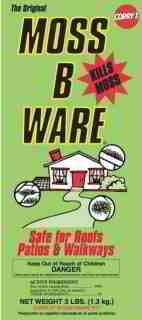 Chemicals that "kill" the moss or lichens on roofs
Chemicals that "kill" the moss or lichens on roofs
can be effective as we illustrate below for a roof located in Seattle where the homeowner applies Corry's Moss B Ware® treatment as a granulated powder sprinkled on the roof along the ridge line. The powder is sprinkled on to a dry roof surface.
Watch out: don't try walking on wet or slippery roof surfaces. It's not the fall that hurts, it's the impact when you hit the ground that is likely to cause severe personal injury.
Moss B Ware® is sprinkled along the roof ridge where subsequent rainfall distributes the chemical (zinc sulfate monohydrate) over the roof surface. The company recommends that the powder should be applied only when the wind speed is less than 10 mph to avoid spreading corrosive dust.
The moss killing powder can be mixed with water to reduce the risk of wind-blown dust hazards to people, animals, or nearby plants or parklands.
The manufacturer of Moss B Ware, Retta Manufacturing in North Bend WA (USA) recommends applying their roof de-mossing product during the rainy season for best results. In 3-4 weeks you should see the moss begin to turn more brown or gray in color and as the moss dies it is "washed away".
Depending on the volume of moss on the roof you may need to clean gutters of the mossy debris.
Watch out: Moss B Ware® uses zinc sulfate monohydrate as its active ingredient to kill moss or lichens on roofs. The product can cause irreversible eye damage and is harmful if absorbed through skin or inhaled.
The company warns not to get the product in your eyes nor in your clothing, to wear protective goggles or face shield, to wash with soap and water after handling and to wash your clothes as well. The MSDS for Moss B Ware® as well as the product label details warn that the product must be kept out of reach of children.
Here are photographs of a Seattle WA roof that has been treated with Moss B Ware®. You can see that small dried fragments of "dead" moss have not washed off of the roof surface (photo at below right) on this rather low-slope roof. But generally the roof surface is nearly free of moss and the remaining fragments are harmless enough to be left alone.
Watch out: as we explain in this article we do not recommend using more aggressive roof cleaning methods such as power washing or rough broom sweeping as forcibly removing live lichens or moss from a roof are likely to damage the roof surface by pulling away the shingle granules. Below is a close-up photo of the dried moss remains on this roof.
Watch out: roof treatment chemicals for algae, lichens or moss may risk also damaging the shingles, may corrode or discolor copper gutters or downspouts, and if not rinsed off of flowers or shrubs or lawns it may damage these plants.
Runoff of some roof treatments for moss or lichens may risk contaminating the environment, and some products may have the further disadvantage that they still leave the moss or lichens in place where it holds water on the roof surface.
Roof Moss Killers & Removers
Updating this article in 2023 we found sources listing nearly ninety "moss removers" and "moss killers" for lawns and roofs - some focused on lawns, a smaller number focused on removing roof moss growth.
Some of these products promise to be low-hazard or even harmless to lawns and odor free (BioAdvanced) while others can be quite harmfujl. Most will work to reduce or over time, kill off and help remove algae, lichens, moss, and mold on roof surfaces.
Watch out: at least some of these products are typically toxic to wildlife and probably should not be used close to lakes & streams or water sources. Depending on where you live and whether or not you're using a product classified as a pesticide, application of roof moss killers may be permitted only by licensed pest control operators.
Watch out: these products typically contain chemicals that are harmful if swallowed, inhaled, or absorbed through skin, and may cause serious injury if gotten in one's eyes. If you're using the hose sprayer version of a roof moss killer you want to attend to wind direction, you may want protective gear, and you must follow roof access safety procedures.
- AllPro Products Lawn Food with Moss Control, not specifically for roofs but might "work" - active ingredient: Ferrous Sulfate Monohyddrate - this is an EPA-registered pesticide
- Bayer Advanced 2-in-1 Moss & Algae Killer, Bayer Environmental Science
95 Chestnut Ridge Road
Montvale, NJ 07645
USA
BayerAdvanced MOSS & ALGAE KILLER MSDS [PDF]
- BioAdvanced Moss & Algae Killer & Cleaner, a garden hose roof spray product. SBM Life Science Co., 1001 Winstead Dr. Ste 500, Cary NC 27513, USA, Tel: 1-877-229-3724 Web: bioadvanced.com
See this BioAdvanced MOSS & ALGAE KILLER PRODUCT USE DIRECTIONS [PDF] from the product label. - Household Bleach, is recommended by some sources such as Better Homes and Gardens as a roof moss, fungi and "mildew" killer.
Typical solution: i1quart of bleach per gallon of clean water to which is added 1/4 cup TSP.
Really? First, there is no mildew on roofs. Mildew is an obligate parasitic form of mold that grows ONLY on living plants.
Second, you can try using bleach on roof lichens, moss, or algae but beware that even if you use the bleach at a safe dilution you risk discoloring the roof and discoloring building siding and trim by insufficiently-rinsed run-off from the roof, and you risk killing plants below as well.
Watch out: never mix ammonia and bleach: you'll create toxic or even fatal chlorine gas! - Lilly Miller MOSS-KILL GRANULES INSTRUCTIONS [PDF] for roofs and other surfaces, retrieved 2023/06/19, original source: www3.epa.gov/pesticides/chem_search/ppls/000802-00591-20050606.pdf
- Moss B Ware is manufactured by Retta Manufacturing, Inc., PO Box 1820, North Bend WA 98045, USA, Website: http://www.corrys.com/
Here is a copy of the MOSS B WARE PRODUCT LABEL [PDF]
and
Here is a copy of the MOSS B WARE PRODUCT MSDS [PDF] - MOSS MELT CONCENTRATE USE STUDY & INSTRUCTIONS [PDF] Oregon State University, - retrieved 2023/-6/19, original source: agsci.oregonstate.edu/sites/agscid7/files/ag-ed-sci/bierma_moss_melt.pdf
Lots of pages of images and some key information about ingredients, safety, effectiveness, use. Focused on lawns.
- Moss Out, Lilly Miller Brands 1000 Parkwood Circle, Suite 700 Atlanta, GA 30339 USA, Web: mossout.com Emergency Telephone: 1-800-265-0761
sold as a hose-end sprayer and as a dry granule application from a shaken canister (better for smaller areas).
MOSS OUT PRODUCT SDS [PDF]
Product Description:
For best results, apply Lilly Miller's Moss Out! For Roofs and Structures just prior to the time when fall rains begin or in early spring. Moss growth can occur in nearly any location where dampness persists.
Such areas include roofs, decks, steps, patios, walks, fence posts, and foundations. Since moisture is essential, most moss growth appears during the fall, some in the winter and in the spring. Very little moss forms in summertime.
Destroying existing moss is done most effectively during times when its growth is most rapid and when rain is not expected for several days.
Controlling moss may add months, or years, of service to roofs, patios and such areas.
Roof Application Instructions:
Shake well before using. Mix one part with 19 parts water (6.8 oz in 1 gallon of water). Apply mixed solution at 0.8-2.5 gallons per 100 ft2 (10-30 fl. oz./yard2).
For moss thicker than one inch use the higher rate. If moss is dry, thoroughly wet moss with water before treating.
Take care to avoid spray or runoff onto desirable plants to prevent plant damage. Treated surfaces may be slippery when wet. If rain falls within one day of treatment, an additional application may be required.
Repeat treatment annually or when new moss or algae is visible. Thoroughly wash equipment after use. - NCAP MOSS ON ROOFS: PESTICIDE-FREE CONTROL [PDF] Clackmas County Water Environment Services & Northwest Center for Alternatives to Pesticides, Web: pesticide.org, retrieved 2023/-06/19, original source: https://dochub.clackamas.us/documents/drupal/ad9e796c-87d8-484e-ad9c-f464e5fef7f9
- Safegro No Moss - active ingredients include clove oil, cottonseed oil, garlic in oil/powder form - this is an EPA "Minimum Risk Pesticide"
- Safer Brand Moss & Algae Killer - active ingredient: Potassium Laurate - this is an EPA Registered Pesticide of low risk to humans and high risk to aquatic life.
- Z-Stop Wood or Composition Roof Products - using Zinc strips - this is an EPA "Minimum Risk Pesticide"
How to Prevent Moss, Lichens & Algae Growth on Roofs
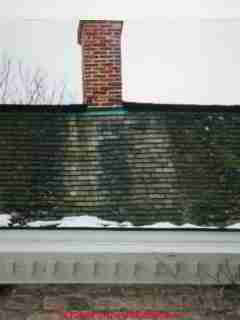 On an asphalt or possibly some (treated) wood shingle roofs, shingle chemistry is also involved in moss, lichens and algae growth or resistance to it. Some roof shingle materials contain algaecides or fungicides which
will also retard moss growth on the roof surface.
On an asphalt or possibly some (treated) wood shingle roofs, shingle chemistry is also involved in moss, lichens and algae growth or resistance to it. Some roof shingle materials contain algaecides or fungicides which
will also retard moss growth on the roof surface.
You'll also notice that moss, lichens, and usually algae and fungus will be conspicuously absent from a roof surface down-roof from areas where galvanized metal, copper, or even aluminum flashing are installed.
Mineral salts washing off of these metals will retard moss or algae growth on the shingles.
Moss, Lichens, Algae Resistant Roof Shingles
Use algae-resistant shingles when re-roofing.
Chemically treated roof shingles are available from several asphalt roofing manufacturers who offer these products which are resistant to moss, lichens, or algae growth on roofs.
Discuss this option with your roofer when it's time to replace the roof.
New asphalt roof shingles are available with an inclusion of chemicals that resist moss, lichens, algae, and even fungal growth.
Resist does not mean moss-proof or lichens proof however for shingles subject to difficult conditions such as extensive shade under trees and lots of organic debris left on the roof surface.
At A BRIEF HISTORY OF ALGAE-RESISTANT AR-SHINGLES AND WHAT THEY ARE MADE-OF we give details about how shingles are made algae resistant - a property that appears to also retard moss growth by using zinc or copper treated mineral granules or flashings.
Metal Flashings & Strips to Retard Moss & Lichens Growth on Roofs
We have observed that the chemical or mineral salt wash-off from some building materials like aluminum flashing, zinc strips, and copper flashing and even some paints which appear to kill of moss, lichens, algae, and fungus, as their extracts are washed over the roof surface.
It's particularly easy to spot this effect by noticing where there are moss-free areas on an otherwise mossy roof surface.
One of our most obvious photos of rain wash off of copper flashing keeping moss off of a roof happens to be on a wood shingle roof, But we see this effect below copper flashing (and often aluminum flashing) on asphalt shingle roofs as well.
Notice the clear area below the turret on top of this wood-shingled pyramid shaped roof located in Key West Florida.
Chemicals from the metal cap atop the turret and from flashing at the turret base appear to be washing down the wood shingles in a path which prevents or even kills off moss, algae, and lichens on this roof (which we viewed from the Key West lighthouse museum.)
Installing copper or other metal strips
along the ridge of an existing roof will slowly kill off moss or lichens as rainwater washes over the metal and down the roof surface. This method is suitable for both prevention of future or further moss or lichens growth on the roof and for gently treating an otherwise fragile old roof.
Here is another photograph demonstrating the effect of copper flashing on algae, moss or lichens on a roof.
Give the roof surface more sunlight
Trim back trees whose branches overshadow the roof surface. Keep the roof clean of organic debris like leaves or pine needles which may collect in valleys or at other roof locations.
Steps to prevent or retard moss growth on roof shingles also work about as well for preventing lichens growth. For advice on diagnosing, cleaning, and preventing algae stains on roofing,
see BLACK STAIN REMOVAL & PREVENTION
Trim back trees too close to the building: see our tree trimming advice
at TREES & SHRUBS, TRIM OFF BUILDING or select a topic from the closely-related articles below, or see the complete ARTICLE INDEX.
Treat the roof surface with a lichens or moss killing chemical such as the Moss B Ware product discussed above
at ROOF TREATMENTS for LICHENS / MOSS
Above and below, photos by Arlene Puentes illustrate how the copper salts washing down from this copper plumbing vent boot flashing prevented moss and growth on the roof of an older New York home, bu only on the roof surfaces below the copper.
Question: What kind of metal strips at the ridge line are recommended to slow or remove moss & algae growth on roofs
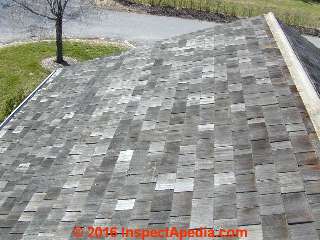 2016/09/02 Anonymous said:
2016/09/02 Anonymous said:
What kind of metal strips at the ridgeline are recommended and most effective, zinc or copper?
[Click to enlarge any image] The galvanized steel ridge flashing helps keep algae and moss from growing on this wood shingle roof, as does the absence of nearby trees and shade. The same effects will be found from metal flashings on asphalt shingle roofs.
Reply: copper or zinc or aluminum
Interesting question Anon. Moss, mold, and algae resistant roof shingles have been around for a while now, so a look at what roofing manufacturers choose to treat their mineral granules would be instructive, except that of course cost will be a critical factor.
Copper and zinc are most-often combined in the forms of cuprous oxide and zinc sulfide to form a copper oxide for moss and algae resistance, is added to most asphalt granule-coated roof materials while some roofing manufacturers use zinc, magnesium, or even titanium dioxide as the mineral granule treatment for moss or algae-resistant asphalt roof coverings.
Some roofing companies also use a ScotchGuard product to improve algae resistance of shingles, though I'd add that my own experience with ScotchGuard on building exteriors found that it needed frequent re-application (such as on masonry surfaces) to maintain its effectiveness.
Here's an excerpt from a GAF roofing warranty statement:
Algae Discoloration. All StainGuard®-labeled Shingles and Ridge Cap Shingles are warranted against algae discoloration for 10 years. There is no coverage for algae
discoloration for any other GAF Accessory Products. - 2016/09/02 retrieved from www.gaf.com/Warranties_Technical_Documents/Steep_Slope_Warranties/GAF_Shingle_Accessory_Warranty.pdf
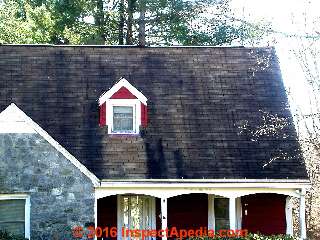 To choose between copper or zinc add-on strips for use on an existing roof to fight off algae and moss, where I've seen good results from copper, zinc, and aluminum flashing in those locations, my guess is that zinc oxide might form more rapidly and wash down the roof surface below more rapidly than copper strips affixed along a ridge or other roof location to try to kill off or prevent moss, algae, or fungus growth on a roof surface, but I also speculate that copper, while more costly, may have a longer effective life in that application.
To choose between copper or zinc add-on strips for use on an existing roof to fight off algae and moss, where I've seen good results from copper, zinc, and aluminum flashing in those locations, my guess is that zinc oxide might form more rapidly and wash down the roof surface below more rapidly than copper strips affixed along a ridge or other roof location to try to kill off or prevent moss, algae, or fungus growth on a roof surface, but I also speculate that copper, while more costly, may have a longer effective life in that application.
So do we want speed or life. Speed might be a reasonable choice since asphalt roof shingles will probably not last as long as either sort of metal strip along the ridge.
There is some research on the interaction of copper, zinc, and other metals with moss; I'll cite it below. Some of those studies were interested in the opposite reaction: removal of copper, zinc or other metals from solutions by moss, peat, or other organic materials, but the interaction and its effectiveness remain.
Our photo above illustrates the remarkable absence of algae staining below the dormer on this New York roof. Take a closer look and you'll see metal flashing running horizontally just below that dormer window.
[Click to enlarge any image.]
Research on Roof Shingle Treatments to Retard Moss, Algae, Lichens, Fungus or Mold Growth
Ho, Y. S., DA John Wase, and C. F. Forster. "Kinetic studies of competitive heavy metal adsorption by sphagnum moss peat." Environmental Technology 17, no. 1 (1996): 71-77.
- Lee, C. K., and K. S. Low. "Removal of copper from solution using moss." Environmental Technology 10, no. 4 (1989): 395-404.
- Panda, Sanjib Kumar, and Shuvasish Choudhury. "Changes in nitrate reductase activity and oxidative stress response in the moss Polytrichum commune subjected to chromium, copper and zinc phytotoxicity." Brazilian Journal of Plant Physiology 17, no. 2 (2005): 191-197.
- Shaw, Jonathan. "Genetic variation for tolerance to copper and zinc within and among populations of the moss, Funaria hygrometrica Hedw." New Phytologist 109, no. 2 (1988): 211-222.
Abstract:
Ten individuals from each of lour populations of the moss, Funaria hygrometrica Hedw., were grown on two copper and two zinc treatments and a control in order to assess tolerance to these metals. Tolerances of two life-history stages (protonemal growth and stem production) showed significant variation among populations, and among individuals within all populations.
Heritabilities for tolerance were high within three populations, but were close to zero within a population that originated on a copper mine.
Phenotypic correlations among growth responses to the five experimental treatments were similar in the four populations, but this reflected a greater similarity among the environmental correlations than among the genotypic correlations.
There was evidence of positive genetic correlations between growth on control medium and growth on media enriched with copper or zinc.
This is in contrast to data from flowering plants and fungi, and raises the question of why tolerant individuals are restricted to contaminated sites in nature. - Shaw, Jonathan. "Effect of environmental pretreatment on tolerance to copper and zinc in the moss Funaria hygrometrica." American Journal of Botany (1987): 1466-1475.
Research on stain and algae resistant shingles
History of those solutions and the common approaches
- Teng, Yihsien. "Algae resistant shingle." U.S. Patent Application No. 11/066,644.
Excerpts: [in current products] ..
To combat algae and/or fungus growth, it is generally known to include metallic granules on the surface of the roofing material. The metallic granules are generally either composed primarily of or coated with a coating containing copper and/or other metals such as zinc.
When wetted by rain or otherwise, the copper and zinc compounds leach out from the roofing material and act as algaecides and/or fungicides to inhibit the growth of the algae and/or fungus. - Joedicke, Ingo B. "Algae-resistant roofing granules." U.S. Patent 6,214,466, issued April 10, 2001.
Excerpts citing other relevant patents are very helpful in this question where we include as does the patent applicant these illustrative examples of prior art compositions:- U.S. Pat. No. 3,494,727 discloses a microbe resistant roof wherein the roofing material contains embedded therein visually observable metallic chips, such as copper, lead, zinc and iron.
- U.S. Pat. No. 3,507,676 discloses zinc-containing coating for roofing granules in the form of zinc, ZnO or ZnS.
- U.S. Pat. No. 3,528,842 discloses copper compound-containing algicidal surfacing, the copper compound being cuprous oxide or cuprous bromide.
- U.S. Pat. No. 3,598,627 discloses fungus-resistant shingles the outside surface of which are asphalt coated and are covered by a hard, granular weathering material and granular zinc.
- U.S. Pat. No. 3,884,706 discloses algicidal roofing granules coated with a substantially water insoluble silicate-clay coating into which small amounts of algicides, e.g. 0.05% to 0.5% zinc algicide and 0.05% to 0.5% copper algicide, are incorporated based on the total weight of the roofing granules.
- U.S. Pat. No. 4,092,441 discloses roofing granule treatment by coating the granules with a metallic algicide, such as zinc, copper, nickel and mixtures thereof. The metals are sprayed onto the granules in the form of molten droplets.
- U.S. Pat. No. 5,382,475 discloses algicidal granules having a ceramic coating thereon comprising three layers, the first two of which have a copper compound, and the third layer has a pigment, a borate compound and zinc oxide.
Differences among algae, lichens, and moss on roofs
If you need to distinguish among algae, lichens, and moss, those differenes are described at
- ALGAE, FUNGUS, LICHENS, MOSS COMPARED - what moss looks like under the microscope.
- ALGAE STAINS on ROOFS - what roof shingle algae looks like under the microscope.
- BLACK STAIN REMOVAL & PREVENTION
- GREEN STAINS ON STONE - green algae and moss on building and artifact surfaces
- STAINS on ROOF SHINGLES - how to identify & explain the most-common asphalt roof shingle failures and how to obtain asphalt roofing shingle failure claims assistance.
Research on Algae & Moss Growth on Roofs
- The Ecology of Algae, F.E. Round, Cambridge University Press, 1984 ISBN-10: 0521269067 ISBN-13: 978-0521269063
After an introduction outlining the chemical and physical characteristics of the environment, the book goes on to look at the actual habitats in which algae occur.
The communities of the individual habitats such as open water, sediments, rocky shores, coral reefs, hot springs, sea ice, soil, etc., are then discussed with special phenomena highlighted, for example rhythmic activity, nitrogen fixation and buoyancy.
There are also chapters on seasonal cycles of algal growth, energy flow, geographical dispersion, palaeo-ecology and contribution to sediments. The importance of algae in symbiotic relationships and their considerable significance to animal grazers in aquatic food chains are also discussed.
The final chapter deals with the relationships of algae to eutrophication and pollution of water. This is an important aspect, which can only be understood through an appreciation of algal ecology. - Guides to identifying mosses: Graphic Guide Ontario Mosses (some of which appear widely dispersed by climate and geographic area, not just in Ontario) which offers a graphic guide to mosses. worldofmosses.com/ggom/index.html
- Shingle Shield™ are zinc strips that are inserted under the shingle tabs of individual shingles to reduce moss, lichens, and algae growth on asphalt roofing - see shingleshield.com
- StainhandleR are zinc strips that are inserted under the shingle tabs of individual shingles to reduce moss, lichens, and algae growth on asphalt roofing- see stainhandler.com
- Zinc-Shield® - zincshield.com and Z-stop™ zinc roofing strips - z-stop.com, are roll-out zinc strips intended for installation near the ridge of a roof to reduce moss, lichens, and algae growth on roofs
- Also see the sources listed at worldofmosses.com/ggom/ggomBibliography.html
Contributor Thanks
Thanks to Arlene Puentes for photo contributions above on this page
- Arlene Puentes [Website: www.octoberhome.com ] , an ASHI member and a licensed home inspector in Kingston, NY, holds five International Code Council Certifications, New York State DOS Certified Code Enforcement Official, ASHI Member 210232, NYS Home Inspector License No. 16000095212and has served on ASHI national committees (Bylaws, Standards), as well as HVASHI Chapter President. Ms. Puentes can be contacted at ap@octoberhome.com She is a frequent technical contributor to InspectApedia.com.
...
Reader Comments, Questions & Answers About The Article Above
Below you will find questions and answers previously posted on this page at its page bottom reader comment box.
Reader Q&A - also see RECOMMENDED ARTICLES & FAQs
On 2020-10-28 - by (mod) -
Algae, Lichens, Moss all love shady roofs - photos of algae & lichens on EPDMPhoto above: Lichens on an EPDM roof on a New York home. [Click to enlarge any image] Lichens is not moss and it's not algae, though all three may be found often on the same roof surface.
Thank you for the comment and question, David.
Of course, you're quite right moss, algae, and lichens are all different organisms. As well as distinguishing among those three organisms in this article, you'll see that they get more detailed stories in additional recommended articles that I list at CONTINUE READING .
I did indeed include all three of these rather different organisms together on this page in part because so many people just see something growing on their roof and want help but have no idea what the growth is.
It's also the case that we very often find both moss and lichens together on roofs and sometimes black staining algae show up at the same time too.
However the same products that retard algae growth on roof shingles and the same products that will "kill" moss on a roof all retard all three organisms.
Please take a look, in the article above on this page, at the moss and lichens prevention products listed in the article section titled
Roof Treatments to Remove or Prevent Algae, Lichens, Moss Growth: Moss B Ware®
And don't hesitate to ask follow-up questions and perhaps to post a photo of the roof of concern.
Watch out: you may have found, as I have, that it is quite risky to mechanically remove or clean or power-wash moss off a roof (and almost impossible to remove lichens).
Worse, trying to do so on an asphalt-granule coated roof such as a shingle roof or granule-faced mod-bit roof very often also rips off the mineral granules, leaving exposed roofing substrate and speeding the end of the life of the roof.
In this article series you'll see that aside from sprinkling killers on roofs (a bit of a worry on some steel roofs and terne-coated roofs), you can often simply run a strip of copper along the ridge;
As long as it's affixed so as to avoid any galvanic reaction problem with your roof, as the copper ages it sheds copper salts - cupric oxide. Those oxides washing down the roof are a pretty good biocide that will retard all three of those roof invaders.
Watch out: while algae growing on an asphalt shingle roof is mostly a cosmetic issue, algae growth on a metal or EPDM roof is incredibly treacherous. Even on a low slope EPDM roof it's easy as pie to slip and slide right off the roof and down to a hard landing below.
My photos above and below show what to the naked eye looks like black slimy stuff (actually mostly algae) growing on the same New York EPDM roof in another more-shaded area.
Above: it looks mostly black in normal light but this is actually thick green algae growing on the surface of the same EPDM roof that in another area sports lichens growth shown earlier on this page.
Below: the same algae shown above is examined under the microscope at 1200x transmitted light in our forensic lab.
You can note the green algae cells that identify this material.
At SLIPPERY STAIRS, WALKS, ROOFS you can read that when wet algae is one of the slipperiest substances known.
Finally,
Does it matter whether you call this "blue algae", "green algae", or "black algae" on a roof?
Yes and No.
If a product warranty is promising to retard just algae of a specific colour such as "blue algae" that may be a subtle trick to weasel out of having to back a product, say a roof shingle, that is stained by green or black algae, identified in a forensic lab like ours.
Black Algae scientific name
To add confusion to the topic, "black algae" is often actually Audouinella, a common genus of red algae found most-often in marine environments.
Green Algae scientific name
Green algae like the material in my lab photo above is typically a member of the genus Oocystis, a member of the Chlorophyta division of the plant kingdom (Viridiplantae); it's green because it contains green chlorophyll a and b.
Yellowish-green algae, for example the species Pleurochloris poyrenoidosa, (less common on roofs, often in swimming pools) is likely to be from a different kingdom: Chromalveolata, in the Xanthophyceae class.
Yellow-green algae gets its colour from chlorophyll forms a and c; it doesn't contain chlorophyll b.
Black Algae or Blue-Green Algae scientific name
Black algae isn't. Actually it's a bacteria, from the phylum Cyanobacteria. As you see in my photos above, this "algae" looks almost jet black on the wet EPDM roof and appeared as a blob of black muck when I scraped some of it up to bring into the lab.
But under the microscope it's clearly greenish; you can do your own "lab" test by smearing some of your black or blue-green algae onto a sheet of clean white paper where you'll probably see the greenish hue. Black or blue-green algae does not contain chlorophyll.
But for practical purposes, any algae growing on any roof surface is going to make a stain that may be black, brown, green, or "bluish" under varying light conditions, and more-serious, any metal or membrane roof that's got algae growing on it is just waiting for a wet day to watch you slip and slide right off the roof surface, so be careful.
On 2020-10-28 by Leonidas Kontogouris
@David J Gill,
I am a roof contractor also and moss is definitely not the same as blue algae
I have a question? What product can I use to prevent liking and moss from growing on a corrugated steel stone coated metal roof?
On 2020-09-08 - by (mod) -
Moss is indeed an entirely different organism than algae, but algae retarding chemicals also retard moss.
And at least two of these organisms, moss and even more-often lichens show up on all sorts of roof materials besides asphalt shingles. I've even found lichens growing on EPDM roofing, as I'll show here.
At ALGAE, FUNGUS, LICHENS, MOSS COMPARED we compare these three organisms and show photographs.
Resistant does NOT mean 100% moss and algae proof. So algae-resistant shingles do not mean "algae-proof" nor "moss proof" nor "lichens proof" which is why in this article series we describe a number of steps to minimize the growth of these three organisms on roof surfaces of all types.
The zinc strip will help.
On 2020-09-08 by David J Gill
I'm about to have a GAF asphalt shingle product installed. The product resists the growth of blue-green algae, but what about moss growth?
We currently have a moss growth problem on the existing 20 year old roof.
I've suggested adding a strip pf zinc along the top edge of the new roof but the roofer seems to think this is not needed.
Is he right or is moss something entirely different than blue-green algae?
...
Continue reading at ALGAE, FUNGUS, LICHENS, MOSS on ROOFS - topic home, or select a topic from the closely-related articles below, or see the complete ARTICLE INDEX.
Or see MOSS on ROOFS, FAQs - questions & answers posted originally on this page
Or see these
Roof Stain Diagnosis, Repair, Prevention Articles
- SLIPPERY STAIRS, WALKS, ROOFS
- STAIN DIAGNOSIS on ROOFS - home
- ALGAE, FUNGUS, LICHENS, MOSS on ROOFS
- BLACK ROOF STAIN CAUSES
- BLACK or GREEN ALGAE STAINS on ROOFS
- BLACK or GREEN ALGAE STAIN REMOVE / PREVENT
- CHIMNEYS, STAINS on / near
- DEBRIS STAINS on ROOFS
- EXTRACTIVE BLEEDING on SHINGLES
- LICHENS on ROOFS
- MOSS on ROOFS
- POWER WASHING ROOFS
- RUST STAINS on ROOFS
- SOOT STAINS on ROOFS
- TARRY BLEED on ROOFS
- TOBACCO JUICING SHINGLE STAINS
- WHITE STAINS on ROOFS
- TEST LABS - ROOF SHINGLE
Suggested citation for this web page
MOSS on ROOFS at InspectApedia.com - online encyclopedia of building & environmental inspection, testing, diagnosis, repair, & problem prevention advice.
Or see this
INDEX to RELATED ARTICLES: ARTICLE INDEX to BUILDING ROOFING
Or use the SEARCH BOX found below to Ask a Question or Search InspectApedia
Ask a Question or Search InspectApedia
Try the search box just below, or if you prefer, post a question or comment in the Comments box below and we will respond promptly.
Search the InspectApedia website
Note: appearance of your Comment below may be delayed: if your comment contains an image, photograph, web link, or text that looks to the software as if it might be a web link, your posting will appear after it has been approved by a moderator. Apologies for the delay.
Only one image can be added per comment but you can post as many comments, and therefore images, as you like.
You will not receive a notification when a response to your question has been posted.
Please bookmark this page to make it easy for you to check back for our response.
IF above you see "Comment Form is loading comments..." then COMMENT BOX - countable.ca / bawkbox.com IS NOT WORKING.
In any case you are welcome to send an email directly to us at InspectApedia.com at editor@inspectApedia.com
We'll reply to you directly. Please help us help you by noting, in your email, the URL of the InspectApedia page where you wanted to comment.
Citations & References
In addition to any citations in the article above, a full list is available on request.
- [1] "Poor Season for Sunshine is a Great One for Spores", William Yardley, The New York Times, 20 April 2011, web search, 20 April 2011, http://www.nytimes.com/2011/04/20/us/20moss.html?_r=1&emc=eta1
- Building Pathology: Principles and Practice, David Watt, Wiley-Blackwell; 2 edition (March 7, 2008) ISBN-10: 1405161035 ISBN-13: 978-1405161039
- Wood Shingle Roofs, Care and Maintenance of wood shingle and shake roofs, (EC), Stanley S. Niemiec (out of print)
- Also see the sources listed at worldofmosses.com/ggom/ggomBibliography.html
- In addition to citations & references found in this article, see the research citations given at the end of the related articles found at our suggested
CONTINUE READING or RECOMMENDED ARTICLES.
- Carson, Dunlop & Associates Ltd., 120 Carlton Street Suite 407, Toronto ON M5A 4K2. Tel: (416) 964-9415 1-800-268-7070 Email: info@carsondunlop.com. Alan Carson is a past president of ASHI, the American Society of Home Inspectors.
Thanks to Alan Carson and Bob Dunlop, for permission for InspectAPedia to use text excerpts from The HOME REFERENCE BOOK - the Encyclopedia of Homes and to use illustrations from The ILLUSTRATED HOME .
Carson Dunlop Associates provides extensive home inspection education and report writing material. In gratitude we provide links to tsome Carson Dunlop Associates products and services.


